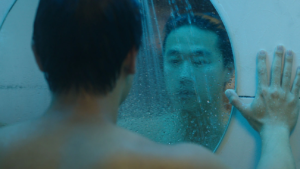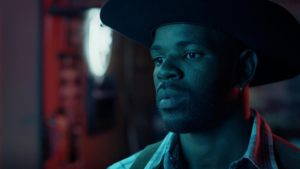How Filmmakers Create New Worlds With Music and Sound
Music and sound design are two of the most powerful tools available to film directors. If you’re looking to enhance the story of your series or feature film with audio, you’ll need to work with a team that includes composers and sound designers. Fortunately, you won’t have to start from scratch. In their Master Class on Building Your Story Soundscape with Music and Sound, Sundance Institute’s Director of Film Music Peter Golub and Glenn Kiser, Director of the Dolby Institute, lead a conversation with award-winning practitioners on how composers and sound designers work with directors to build the world of a film and shape its story and overall message. Read on for some key takeaways from their discussion.
Sound Can Define the Audience Experience
“Sound is such a big part of our existence,” says panelist Hildur Gu∂nadóttir (Joker, Chernobyl). For the Academy Award, Golden Globe, Grammy, Emmy, and BAFTA winning composer and artist, the process of writing a score should begin as early as possible. When a director has an idea of how they want to present their story, Gu∂nadóttir will get to work on researching the story, characters, theme, and tone of the project immediately.
With Chernobyl, the HBO series based on the 1986 nuclear disaster at a power plant near Pripyat, Ukraine, the composer wanted to create a score in which sound, natural noise, and music blended into the aesthetic of the world, and she began her work with a visit to a power plant similar to the one that had existed at Chernobyl. “It’s a very important story to be told, so I felt that it was very important not to dramatize it, I wanted to stay close to the reality of it,” she says, adding that “I wanted the music to be like radiation.” So to understand what radiation could sound like, she recorded and listened to the landscape and felt that the power plant was telling its own story. There is not a single instrument in the actual score; rather, all the sounds are coming from the power plant itself as well as distorted clips of her own voice.
As Golub points out, there’s a deep, organic, internal quality to the score of Chernobyl that really highlights the tragedy of the story and makes the audience feel as though we are experiencing the fallout along with the characters, rather than acting as a sort of commentary on the situation, which is a very powerful creative choice for telling the story.
Music and Sound Will Get You Into the Mind of a Character
While scoring Joker, Gu∂nadóttir always kept her focus on the main protagonist and his experience in the story. ”His internal world was very simplistic. He’s trying his best to be a human being, and he doesn’t really understand why that doesn’t work for him,” she says of the film’s titular character, played by Joaquin Phoenix.
When director Todd Philips asked her to work on the project, she was thrilled to be a part of the process of creating such important social commentary disguised as a superhero movie. “Where does a villain come from?” she asked. “The film is about the human experience of how we treat people who are mentally ill.” With that in mind, she kept the film’s music very personal to the main character and what he was going through at any given point in the story. As Golub observes, Gu∂nadóttir uses a minor third often, which is not a traditional theme in terms of a melody, but those two notes tend to feel obsessive and claustrophobic. “You create a whole world inside those notes,” he says. “He’s not thinking he’s a killer, he’s finding himself. This is the great thing music can do to tell a story, not to moralize, but to tell the experience of a character.”
Director and fellow panelist Kitty Green (Ukraine is Not a Brothel, Casting Jonbenet) had this mind while filming The Assistant, a drama inspired by the events that kickstarted the recent #MeToo movement in Hollywood. Music and sound can establish a character’s internal state of mind as well as creating a sense of external pressure that weighs on them. Green wanted to create a sense of fear in the mundane setting of an office; the sounds of copiers whirling, fluorescent lights buzzing, doors opening and closing, and traffic noises coming through the windows can actually be quite intimidating when paired with an uncomfortable situation. Sound Designer Leslie Shatz (Making a Murderer, Dark Waters) was up for the task, because “art is the essence of reality,” he says.
In addition to creating a sense of danger around the film’s main character as she works through her daily routine at the office, Green also made the creative decision not to show the film’s antagonist on screen, but rather, only portray him through sound. In fact, snippets of conversation overheard by the main character are not entirely audible, yet the audience is clearly able to understand who he is as a person just through his tone of voice. “You needed to sense the power of this man, because the machine around him is what I was exploring, and you needed to see how corrosive his power was,” Green says. By only using the sound, she and Shatz created a sense of terror without making the film about this individual character.
Listen to the Music—and Your Collaborators
Gu∂nadóttir has a key piece of advice for creatives: “It’s not what you say, it’s how you listen.” Listening, she says, is 90% of collaboration. Composer Tamar-kali (Mudbound, The Last Thing He Wanted) has a similar view on her experience working with Green on The Assistant. She recalls Green coming to her with questions about how to create the right sense of tension in the film, but knowing from the beginning what the film needed to achieve. “You have an idea of the direction you want to go in, but you’re open to hearing suggestions. That’s a sign of a good leader,” Tamar-kali says.
Shatz had a similar experience with Green, adding, “As a sound designer, I’m only as good as the movie I’m being asked to work on.” There must be a strong sense of trust in each other when working together on a film, and Green’s willingness to be fully present in the sound design and score for her film allowed her collaborators to bring their best work to the table.
For The Assistant, Green ultimately decided to have Tamar-kali bookend the movie with subtle music cues without using any music in the rest of the film. “There was a lot of trauma wrapped up in everything that was coming out day by day,” Green says, referring to the real-life events that inspired the film. “We didn’t want to seem exploitative or sensationalist. It was going to be very minimalist, scene by scene, minute by minute, a day in the life.” Communicating the story with a certain level of sensitivity led her to want to let the audience settle in and get comfortable with the character before letting the film’s message shine through. Keeping the score to a minimum helped create a story without emotionally manipulating the audience into thinking they knew what would happen to the film’s main character.
Of course, collaboration does not only exist with the director; there are times when the rest of the creative team will work together to build a stronger film. Gu∂nadóttir recalls a time while filming an intense scene in Joker in which the character has just committed his first murder, and Phoenix was unsatisifed with how the scene was originally scripted. He felt that in its original form, which had the character run into a public bathroom and begin to panic, the scene wasn’t particularly character-driven. To work through it, Philips had him listen to Gu∂nadóttir’s score. Phoenix took a quiet moment to feel what the music was trying to convey and began to dance. The Cinematographer, Lawrence Sher, began to dance with him, and the moment made it into the final cut of the film.
The legendary film editor Walter Murch once said, “Sound is the backdoor in which information comes to the viewer.” Sound and music are key to building a compelling world on screen, so it is essential to find a composer and a sound designer willing to collaborate and understand the nuances of your story and characters to ultimately create a strong emotional journey for an audience.
To learn more from Hildur Gu∂nadóttir, Kitty Green, and Tamar-kali, including their analysis of scenes from Chernobyl, The Assistant, and Joker, watch the full Master Class: Building Your Story Soundscape with Music and Sound – Presented by The Dolby Institute



